Blocking Clutch
Here comes some nice story of my beginner's experiences with engine and clutch.
I had not been flying for two weeks, due to stormy weather, and
I had been looking forward for flying
already for a week. So I was quite eager to fly when, after
a heavy hailstorm, the weather suddenly became
very good in the evening (cloudless, no wind!).
So after 45 minutes of walking through the mud and putting together my raptor,
I was finally ready to start.
However, my engine seemed blocked completely. No way to move it around, with the glowplug
removed. Neither with the starter nor by hand.

Aargh! Finally good weather, and then the engine is locked!
From the last time I ran the engine I did not remember anything
special: I had run it for only a few minutes, and not on top speed, just
to check the tracking and some previous problems with noise on the servos (see
tip on servo noise). I had had no problems cutting down the engine.
As my engine was maybe a month old, I dediced to return it to the shop where I bought
it. Of course without all the attributes. Thus I started removing the
pipe, clutch and fan. The fan is locked very tightly with the engine nut, and I did not use
the piston lock - my engine was blocked anyway so no need for that. But -surprise!- the
engine suddenly gave way while attempting to remove that last nut, and
it rotated as if nothing had happened.
I found a lot of brown rusted-water like fluid coming out of the engine:
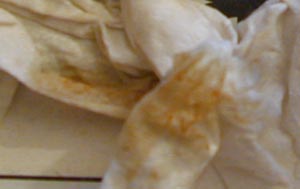
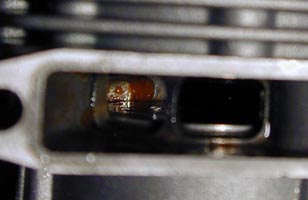
|
Some rusty fluid from the engine
|
Look through the exhaust outlet into the engine.
The brown hole in the middle is the fuel inlet (coming from the back of the piston).
A lot of this rusty stuff kept coming out this fuel inlet.
|
The cylinder had been locked in a high position (the 'fuel has been compressed' state),
and someone from the local shop
suggested that I could have experienced a hydrolock. But considering information about
hydrolock on some
web
pages
this seems extremely unlikely, as the air inlet in the raptor will only catch
lots of water if you go diving with a running raptor and it was not even raining then.
Anyway, the engine was unlocked and it was running again. The next day I did some flying.
But as soon as it started running with enough power to lift off, the
radio interference problems (see below) returned.
I suspected something rustingsomewhere inside,
maybe because the highly hygroscopic fuel remaining in the engine has attracted
some water from the air.
This idea is supported by the fact that I experienced this problem to a lighter extend earlier,
when the engine had been unused for one week. At that time removing the glow plug,
and turning it by hand resolved the problem.
The rusting part seemed to be somewhere below the cylinder.
I opened up the engine, and indeed I found a suspicious brown looking part:
the wrist pin (item 7 in the
exploded view).
It is hard to photograph that pin, but here is one of my three attempts:
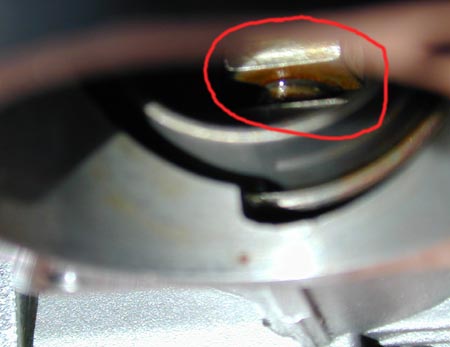
|
the wrist pin, with brown stuff on it. Also note the high local
concentration of the brown fluid.
|
|
I contacted the local model shop, and they assured me that this photo did not look disturbing.
So I closed the engine and the next weekend I tried to start it. However, the clutch
blocked after the first turn with the starter,
probably because I had not fastened the "prop nut" tight enough (see "Fastening the fan").
I dismounted the engine
to tighten the nut, and now I discovered that the cooling fan rotated quite badly.
When turning it, it felt like an electric step motor.
This feeling directly indicates a ball bearing problem. I knew roughly how to open the
engine further, to get to the bearings,
but I wanted to have some expert doing this the first time before attempting this
myself. So after my long weekend (in which I had planned to fly :-(( ) I went to the local
model shop again, and they opened it (see here).
The rear ball bearing showed malfunctioning. It is
completely black on the engine side. If you scrape with your nail over it,
a very tiny amount of brown stuff comes off, probably some oil-like residue. But
the metal stays dull black. At that time I thought this was the cause of the
blocking engine problem, but now I know that the loose fan locked it up, and probably
it also damaged the bearing. Most likely, the brown stuff was coming off the broken bearing.
This loose fan can also have caused the radio interference.
The shop man thought that this corrosion was
caused by engine fuel staying in the engine, attracting water and oxidizing the
metal. The extension of the oxydation on the side of the bearing
supports this idea: it exactly aligns with the hole to let the fuel to the
upper part of the cylinder. To explain that the aluminium parts
were hardly affected, we have to assume that aluminium oxyde is less sensitive to oxydation
than the hardened steel crankshaft and wristpen.
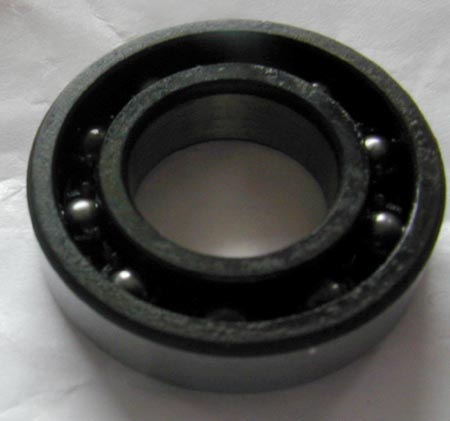
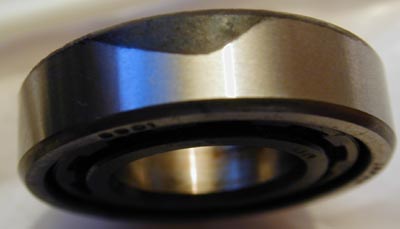
|
The real cause of the blocking engine: a heavily oxidized rear bearing. I heard
that if there is a bearing problem, 9 out of 10 chances that it is the rear bearing.
Click on the image for a larger view.
|
An extension of the corrosion on the side of the bearing. The rest
of the side is not oxidized at all.
|
Another explanation for the broken bearing
is that there has been some overheating inside the engine. But
I would expect that such overheating problems show up mainly in the upper part
of the cylinder and not in the lower part where fresh fuel is constantly
entering.
I have tried to avoid corrosion problem
(successfully) with my new bearings in the future as follows:
1. disconnect the fuel supply with a running engine and let the engine run dry,
to remove all fuel from the engine (instead of attempting to start it again
as suggested in the manual).
2. remove fuel from the pipe as much as possible, by rotating the helicopter and
shaking it a little,to guide fuel remains from the engine through the pipe,
so that unburned fuel cannot return into the engine.
3. Use after-run oil.
4. The engine is tuned now extremely rich.
5. I switched to 5% engine fuel. A ran a short time with wonder-oil instead of synthetic oil,
but now it's synthetic oil again.
And the wrist pen? It came out very difficult when dismounting the engine,
the shop man thought even that it was bent.
I ordered a new one to be sure, but it seems it was just very
dirty and oxydized (but not as bad as the bearing, except for the left point of the pen, which looks very similar.
It fits quite good now I have cleaned it. So there
was definitely no rust on the pin, although in the center of the pin the metal has been changed
just as on the crankshaft.
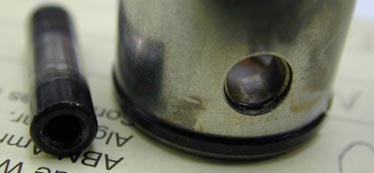
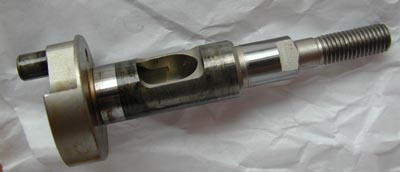
|
The wristpen was very dirty (kind of oxidized?),
especially the part directly exposed to the fuel.
|
The crankshaft. Notice the oxydation only where there is contact with fuel -
assuming that the bearings are tight enough to keep the fuel out.
|
Mr bonk seems to have the same problem, see his posting at the
rcuniverse news group (stripped copy of the thread is
here).
© W.Pasman, 15/4/01







